Jiayuan Gu
SoFar: Language-Grounded Orientation Bridges Spatial Reasoning and Object Manipulation
Feb 18, 2025Abstract:Spatial intelligence is a critical component of embodied AI, promoting robots to understand and interact with their environments. While recent advances have enhanced the ability of VLMs to perceive object locations and positional relationships, they still lack the capability to precisely understand object orientations-a key requirement for tasks involving fine-grained manipulations. Addressing this limitation not only requires geometric reasoning but also an expressive and intuitive way to represent orientation. In this context, we propose that natural language offers a more flexible representation space than canonical frames, making it particularly suitable for instruction-following robotic systems. In this paper, we introduce the concept of semantic orientation, which defines object orientations using natural language in a reference-frame-free manner (e.g., the ''plug-in'' direction of a USB or the ''handle'' direction of a knife). To support this, we construct OrienText300K, a large-scale dataset of 3D models annotated with semantic orientations that link geometric understanding to functional semantics. By integrating semantic orientation into a VLM system, we enable robots to generate manipulation actions with both positional and orientational constraints. Extensive experiments in simulation and real world demonstrate that our approach significantly enhances robotic manipulation capabilities, e.g., 48.7% accuracy on Open6DOR and 74.9% accuracy on SIMPLER.
CAST: Component-Aligned 3D Scene Reconstruction from an RGB Image
Feb 18, 2025Abstract:Recovering high-quality 3D scenes from a single RGB image is a challenging task in computer graphics. Current methods often struggle with domain-specific limitations or low-quality object generation. To address these, we propose CAST (Component-Aligned 3D Scene Reconstruction from a Single RGB Image), a novel method for 3D scene reconstruction and recovery. CAST starts by extracting object-level 2D segmentation and relative depth information from the input image, followed by using a GPT-based model to analyze inter-object spatial relationships. This enables the understanding of how objects relate to each other within the scene, ensuring more coherent reconstruction. CAST then employs an occlusion-aware large-scale 3D generation model to independently generate each object's full geometry, using MAE and point cloud conditioning to mitigate the effects of occlusions and partial object information, ensuring accurate alignment with the source image's geometry and texture. To align each object with the scene, the alignment generation model computes the necessary transformations, allowing the generated meshes to be accurately placed and integrated into the scene's point cloud. Finally, CAST incorporates a physics-aware correction step that leverages a fine-grained relation graph to generate a constraint graph. This graph guides the optimization of object poses, ensuring physical consistency and spatial coherence. By utilizing Signed Distance Fields (SDF), the model effectively addresses issues such as occlusions, object penetration, and floating objects, ensuring that the generated scene accurately reflects real-world physical interactions. CAST can be leveraged in robotics, enabling efficient real-to-simulation workflows and providing realistic, scalable simulation environments for robotic systems.
AffordDP: Generalizable Diffusion Policy with Transferable Affordance
Dec 04, 2024



Abstract:Diffusion-based policies have shown impressive performance in robotic manipulation tasks while struggling with out-of-domain distributions. Recent efforts attempted to enhance generalization by improving the visual feature encoding for diffusion policy. However, their generalization is typically limited to the same category with similar appearances. Our key insight is that leveraging affordances--manipulation priors that define "where" and "how" an agent interacts with an object--can substantially enhance generalization to entirely unseen object instances and categories. We introduce the Diffusion Policy with transferable Affordance (AffordDP), designed for generalizable manipulation across novel categories. AffordDP models affordances through 3D contact points and post-contact trajectories, capturing the essential static and dynamic information for complex tasks. The transferable affordance from in-domain data to unseen objects is achieved by estimating a 6D transformation matrix using foundational vision models and point cloud registration techniques. More importantly, we incorporate affordance guidance during diffusion sampling that can refine action sequence generation. This guidance directs the generated action to gradually move towards the desired manipulation for unseen objects while keeping the generated action within the manifold of action space. Experimental results from both simulated and real-world environments demonstrate that AffordDP consistently outperforms previous diffusion-based methods, successfully generalizing to unseen instances and categories where others fail.
3D-Adapter: Geometry-Consistent Multi-View Diffusion for High-Quality 3D Generation
Oct 24, 2024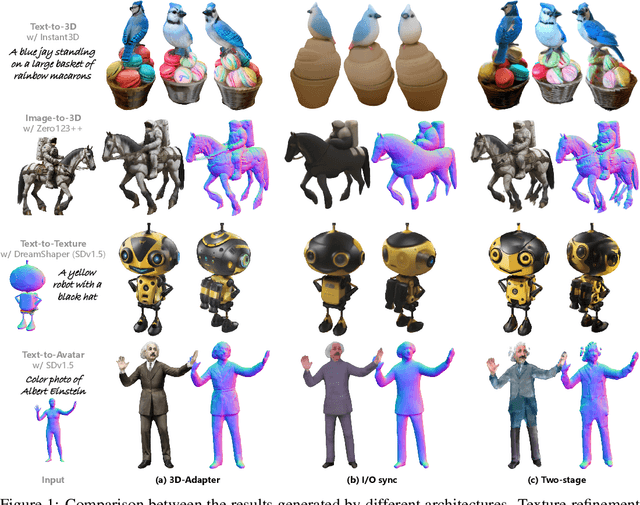
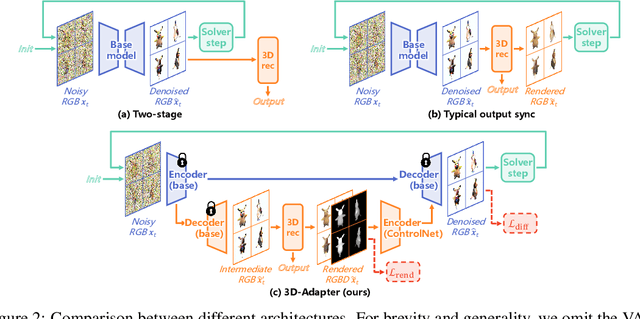
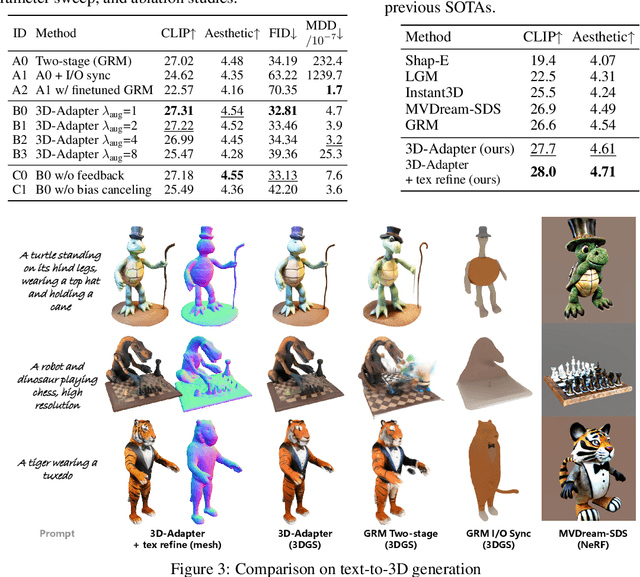
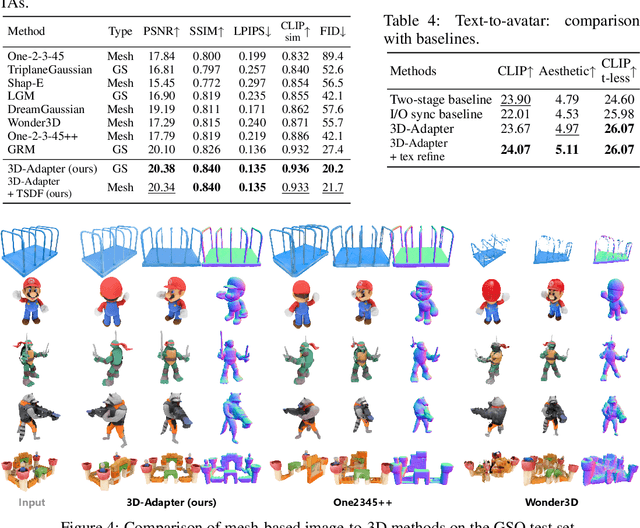
Abstract:Multi-view image diffusion models have significantly advanced open-domain 3D object generation. However, most existing models rely on 2D network architectures that lack inherent 3D biases, resulting in compromised geometric consistency. To address this challenge, we introduce 3D-Adapter, a plug-in module designed to infuse 3D geometry awareness into pretrained image diffusion models. Central to our approach is the idea of 3D feedback augmentation: for each denoising step in the sampling loop, 3D-Adapter decodes intermediate multi-view features into a coherent 3D representation, then re-encodes the rendered RGBD views to augment the pretrained base model through feature addition. We study two variants of 3D-Adapter: a fast feed-forward version based on Gaussian splatting and a versatile training-free version utilizing neural fields and meshes. Our extensive experiments demonstrate that 3D-Adapter not only greatly enhances the geometry quality of text-to-multi-view models such as Instant3D and Zero123++, but also enables high-quality 3D generation using the plain text-to-image Stable Diffusion. Furthermore, we showcase the broad application potential of 3D-Adapter by presenting high quality results in text-to-3D, image-to-3D, text-to-texture, and text-to-avatar tasks.
Point-SAM: Promptable 3D Segmentation Model for Point Clouds
Jun 25, 2024Abstract:The development of 2D foundation models for image segmentation has been significantly advanced by the Segment Anything Model (SAM). However, achieving similar success in 3D models remains a challenge due to issues such as non-unified data formats, lightweight models, and the scarcity of labeled data with diverse masks. To this end, we propose a 3D promptable segmentation model (Point-SAM) focusing on point clouds. Our approach utilizes a transformer-based method, extending SAM to the 3D domain. We leverage part-level and object-level annotations and introduce a data engine to generate pseudo labels from SAM, thereby distilling 2D knowledge into our 3D model. Our model outperforms state-of-the-art models on several indoor and outdoor benchmarks and demonstrates a variety of applications, such as 3D annotation. Codes and demo can be found at https://github.com/zyc00/Point-SAM.
Evaluating Real-World Robot Manipulation Policies in Simulation
May 09, 2024



Abstract:The field of robotics has made significant advances towards generalist robot manipulation policies. However, real-world evaluation of such policies is not scalable and faces reproducibility challenges, which are likely to worsen as policies broaden the spectrum of tasks they can perform. We identify control and visual disparities between real and simulated environments as key challenges for reliable simulated evaluation and propose approaches for mitigating these gaps without needing to craft full-fidelity digital twins of real-world environments. We then employ these approaches to create SIMPLER, a collection of simulated environments for manipulation policy evaluation on common real robot setups. Through paired sim-and-real evaluations of manipulation policies, we demonstrate strong correlation between policy performance in SIMPLER environments and in the real world. Additionally, we find that SIMPLER evaluations accurately reflect real-world policy behavior modes such as sensitivity to various distribution shifts. We open-source all SIMPLER environments along with our workflow for creating new environments at https://simpler-env.github.io to facilitate research on general-purpose manipulation policies and simulated evaluation frameworks.
Generic 3D Diffusion Adapter Using Controlled Multi-View Editing
Mar 19, 2024



Abstract:Open-domain 3D object synthesis has been lagging behind image synthesis due to limited data and higher computational complexity. To bridge this gap, recent works have investigated multi-view diffusion but often fall short in either 3D consistency, visual quality, or efficiency. This paper proposes MVEdit, which functions as a 3D counterpart of SDEdit, employing ancestral sampling to jointly denoise multi-view images and output high-quality textured meshes. Built on off-the-shelf 2D diffusion models, MVEdit achieves 3D consistency through a training-free 3D Adapter, which lifts the 2D views of the last timestep into a coherent 3D representation, then conditions the 2D views of the next timestep using rendered views, without uncompromising visual quality. With an inference time of only 2-5 minutes, this framework achieves better trade-off between quality and speed than score distillation. MVEdit is highly versatile and extendable, with a wide range of applications including text/image-to-3D generation, 3D-to-3D editing, and high-quality texture synthesis. In particular, evaluations demonstrate state-of-the-art performance in both image-to-3D and text-guided texture generation tasks. Additionally, we introduce a method for fine-tuning 2D latent diffusion models on small 3D datasets with limited resources, enabling fast low-resolution text-to-3D initialization.
RT-Sketch: Goal-Conditioned Imitation Learning from Hand-Drawn Sketches
Mar 05, 2024



Abstract:Natural language and images are commonly used as goal representations in goal-conditioned imitation learning (IL). However, natural language can be ambiguous and images can be over-specified. In this work, we propose hand-drawn sketches as a modality for goal specification in visual imitation learning. Sketches are easy for users to provide on the fly like language, but similar to images they can also help a downstream policy to be spatially-aware and even go beyond images to disambiguate task-relevant from task-irrelevant objects. We present RT-Sketch, a goal-conditioned policy for manipulation that takes a hand-drawn sketch of the desired scene as input, and outputs actions. We train RT-Sketch on a dataset of paired trajectories and corresponding synthetically generated goal sketches. We evaluate this approach on six manipulation skills involving tabletop object rearrangements on an articulated countertop. Experimentally we find that RT-Sketch is able to perform on a similar level to image or language-conditioned agents in straightforward settings, while achieving greater robustness when language goals are ambiguous or visual distractors are present. Additionally, we show that RT-Sketch has the capacity to interpret and act upon sketches with varied levels of specificity, ranging from minimal line drawings to detailed, colored drawings. For supplementary material and videos, please refer to our website: http://rt-sketch.github.io.
PartSLIP++: Enhancing Low-Shot 3D Part Segmentation via Multi-View Instance Segmentation and Maximum Likelihood Estimation
Dec 05, 2023Abstract:Open-world 3D part segmentation is pivotal in diverse applications such as robotics and AR/VR. Traditional supervised methods often grapple with limited 3D data availability and struggle to generalize to unseen object categories. PartSLIP, a recent advancement, has made significant strides in zero- and few-shot 3D part segmentation. This is achieved by harnessing the capabilities of the 2D open-vocabulary detection module, GLIP, and introducing a heuristic method for converting and lifting multi-view 2D bounding box predictions into 3D segmentation masks. In this paper, we introduce PartSLIP++, an enhanced version designed to overcome the limitations of its predecessor. Our approach incorporates two major improvements. First, we utilize a pre-trained 2D segmentation model, SAM, to produce pixel-wise 2D segmentations, yielding more precise and accurate annotations than the 2D bounding boxes used in PartSLIP. Second, PartSLIP++ replaces the heuristic 3D conversion process with an innovative modified Expectation-Maximization algorithm. This algorithm conceptualizes 3D instance segmentation as unobserved latent variables, and then iteratively refines them through an alternating process of 2D-3D matching and optimization with gradient descent. Through extensive evaluations, we show that PartSLIP++ demonstrates better performance over PartSLIP in both low-shot 3D semantic and instance-based object part segmentation tasks. Code released at https://github.com/zyc00/PartSLIP2.
One-2-3-45++: Fast Single Image to 3D Objects with Consistent Multi-View Generation and 3D Diffusion
Nov 14, 2023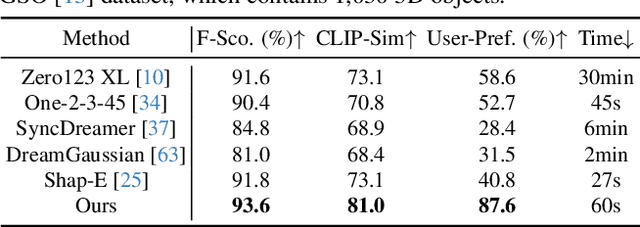


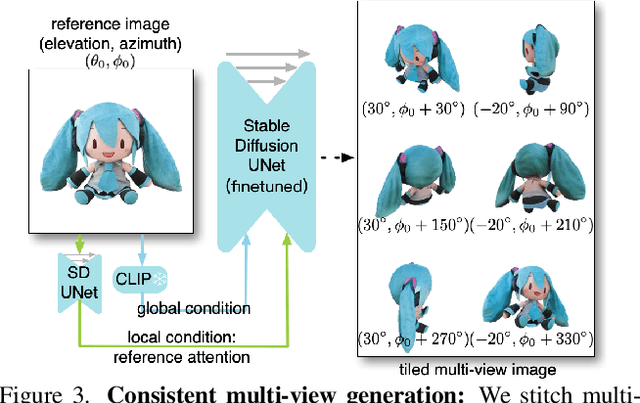
Abstract:Recent advancements in open-world 3D object generation have been remarkable, with image-to-3D methods offering superior fine-grained control over their text-to-3D counterparts. However, most existing models fall short in simultaneously providing rapid generation speeds and high fidelity to input images - two features essential for practical applications. In this paper, we present One-2-3-45++, an innovative method that transforms a single image into a detailed 3D textured mesh in approximately one minute. Our approach aims to fully harness the extensive knowledge embedded in 2D diffusion models and priors from valuable yet limited 3D data. This is achieved by initially finetuning a 2D diffusion model for consistent multi-view image generation, followed by elevating these images to 3D with the aid of multi-view conditioned 3D native diffusion models. Extensive experimental evaluations demonstrate that our method can produce high-quality, diverse 3D assets that closely mirror the original input image. Our project webpage: https://sudo-ai-3d.github.io/One2345plus_page.
 Add to Chrome
Add to Chrome Add to Firefox
Add to Firefox Add to Edge
Add to Edge